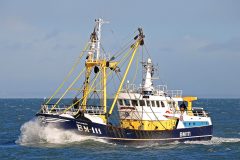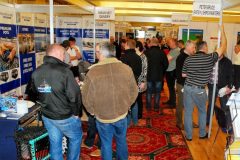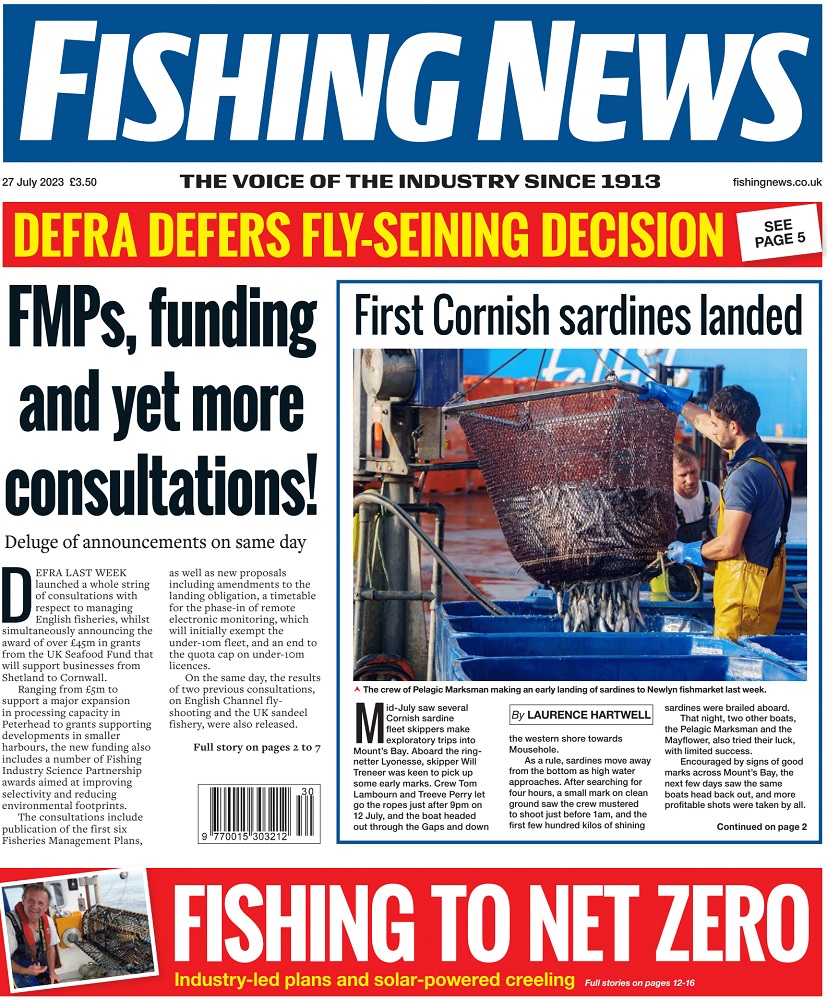John Addison looks back on a trend-setting succession of anchor-seiners built at Herd and Mackenzie’s boatyard at Peterhead between 1954 and 1961.
During the late 1940s and the early 1950s, a number of traditional Danish anchor-seiners from Grimsby and Esbjerg fished in the Moray Firth between October and March each year, before returning to the Dogger Bank for the summer months, when more favourable weather conditions could be expected.
Fishing in relatively close proximity to Buckie in the winter months regularly led to anchor-seiners skippers berthing their vessels at the Moray harbour between trips, and when the boats were tied up over Christmas.
As a result of this well-established practice, the three Buckie boatyards, Herd and Mackenzie, Jones, and Thomsons, often carried out routine maintenance and repair work on anchor-seiners. This enabled boatyard personnel to quickly establish good working relationships with anchor skippers, at the same time as building up their practical knowledge of anchor-seiners.
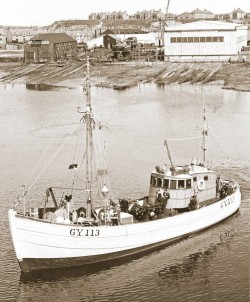
Susitna was the first anchor-seiner to be built by Herd and Mackenzie.
Almost inevitably, the developing bonds between boatyards skippers led to some of the numerous companies in Grimsby, Hull, Fleetwood and Whitehaven that owned anchor-seiners starting to make enquiries about the possibility of Buckie yards building this particular style of boat, which until this time had almost exclusively been built in Denmark.
The first two anchor seiners, Thompaul WA 10 and Alant WA 12, were launched from Thomson’s yard in 1950.
In 1954, Volmar Neilson of Cleethorpes invited John Mackenzie, of Herd and Mackenzie, to Grimsby. Following this visit, skipper Neilson, one of many Danish anchor-seiner skippers who, together with their families, moved to Grimsby during WWII, immediately commissioned Herd and Mackenzie to design him such a vessel.
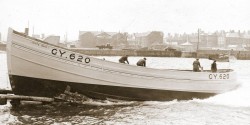
White Bank goes down the ways 56 years ago.
This was the anchor-seiner Susitna GY 113, built at Herd and Mackenzie’s Peterhead boatyard in 1955. With a LOA of 65.10ft, 18ft of beam and a moulded depth of 8.9ft, Susitna was powered by a 152hp Gardner 8L3 engine, and was quickly followed by her sistership Kyana.

Kyanna takes to the water for the first time in 1956.
The successful performance and seakeeping attributes of Susitna proved to be the catalyst for a succession of many other orders for Herd and Mackenzie, with a further 15 anchor-seiners being built between 1955 and 1961, including:
- 1956 – Kyana GY 232; Coral Bank GY 339
- 1957 – Viborg H 33; Nordborg H 35; Ling Bank GY 426
- 1958 – Alatna GY 454; Saxon II GY 499; Sandringham GY 481; Britta GY 595
- 1959 – Saxon King GY 629; Rona Hansen GY 599; Binks GY 617
- 1960 – White Bank GY 620; 1960 Tanana GY 647
- 1961 – Bennison GY 492
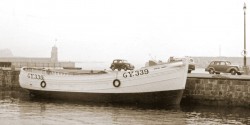
Coral Bank after her launching in 1956.
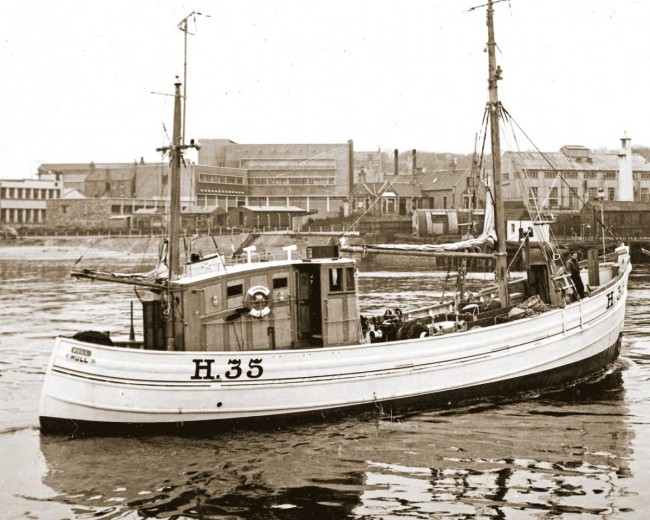
Nordborg.
This succession of new anchor-seiners came to an end when the government grant and loan system to build fishing vessels ceased, and boatyards had to diversify into building other types of vessels to survive, until 1964-1965 when another grant system was formed to restart a building programme for new fishing vessels.

Lingbank is launched at Peterhead in 1957…
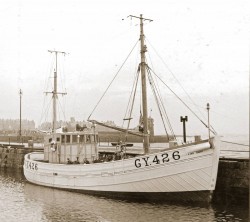
… before being fitted out.
Details of the eight other anchor-seiners built at Herd and Mackenzie’s Buckie yard will be included in Fishing News soon.
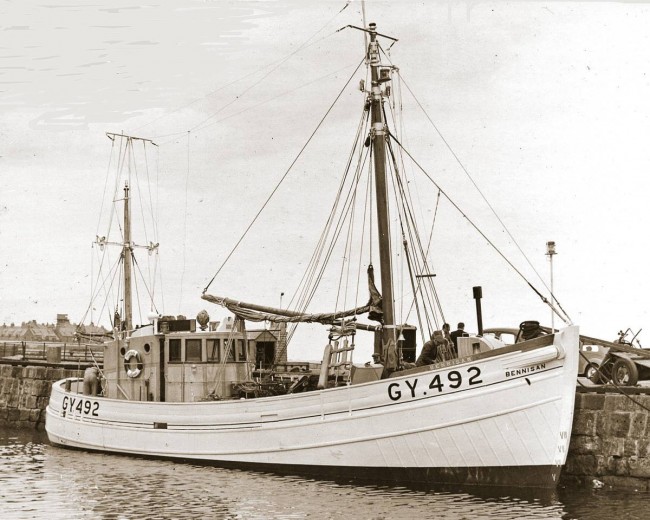
Bennison was the last anchor-seiner to be built by Herd and Mackenzie at Peterhead.
Head to our nostalgia section for more from commercial fishing’s history…


John Addison looks back on a trend-setting succession of anchor-seiners built at Herd and Mackenzie’s boatyard at Peterhead between 1954 and 1961. During the late 1940s and the early 1950s, a number of traditional Danish anchor-seiners from Grimsby and Esbjerg fished in the Moray Firth between October and March each year, before returning to the Dogger Bank for the summer months, when more favourable weather conditions could be expected. Fishing in relatively close proximity to Buckie in the winter months regularly led to anchor-seiners skippers berthing their vessels at the Moray harbour between trips, and when the boats were tied up over Christmas. As a result of this well-established practice, the three Buckie boatyards, Herd and Mackenzie, Jones, and Thomsons, often carried out routine maintenance and repair work on anchor-seiners. This enabled boatyard personnel to quickly establish good working relationships with anchor skippers, at the same time as building up their practical knowledge of anchor-seiners.

Susitna was the first anchor-seiner to be built by Herd and Mackenzie.
Almost inevitably, the developing bonds between boatyards skippers led to some of the numerous companies in Grimsby, Hull, Fleetwood and Whitehaven that owned anchor-seiners starting to make enquiries about the possibility of Buckie yards building this particular style of boat, which until this time had almost exclusively been built in Denmark. The first two anchor seiners, Thompaul WA 10 and Alant WA 12, were launched from Thomson’s yard in 1950. In 1954, Volmar Neilson of Cleethorpes invited John Mackenzie, of Herd and Mackenzie, to Grimsby. Following this visit, skipper Neilson, one of many Danish anchor-seiner skippers who, together with their families, moved to Grimsby during WWII, immediately commissioned Herd and Mackenzie to design him such a vessel.

White Bank goes down the ways 56 years ago.
This was the anchor-seiner Susitna GY 113, built at Herd and Mackenzie’s Peterhead boatyard in 1955. With a LOA of 65.10ft, 18ft of beam and a moulded depth of 8.9ft, Susitna was powered by a 152hp Gardner 8L3 engine, and was quickly followed by her sistership Kyana.

Kyanna takes to the water for the first time in 1956.
The successful performance and seakeeping attributes of Susitna proved to be the catalyst for a succession of many other orders for Herd and Mackenzie, with a further 15 anchor-seiners being built between 1955 and 1961, including:
- 1956 – Kyana GY 232; Coral Bank GY 339
- 1957 – Viborg H 33; Nordborg H 35; Ling Bank GY 426
- 1958 – Alatna GY 454; Saxon II GY 499; Sandringham GY 481; Britta GY 595
- 1959 – Saxon King GY 629; Rona Hansen GY 599; Binks GY 617
- 1960 – White Bank GY 620; 1960 Tanana GY 647
- 1961 – Bennison GY 492

Coral Bank after her launching in 1956.

Nordborg.
This succession of new anchor-seiners came to an end when the government grant and loan system to build fishing vessels ceased, and boatyards had to diversify into building other types of vessels to survive, until 1964-1965 when another grant system was formed to restart a building programme for new fishing vessels.

Lingbank is launched at Peterhead in 1957…

… before being fitted out.
Details of the eight other anchor-seiners built at Herd and Mackenzie’s Buckie yard will be included in Fishing News soon.

Bennison was the last anchor-seiner to be built by Herd and Mackenzie at Peterhead.
Head to our nostalgia section for more from commercial fishing’s history…


